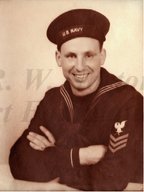
|

|
|
|
|
Arnold was born in Oakdale, Louisiana, to Willie Dunn Young and Elna Harmon Young. He was the oldest of five brothers and one sister. His father worked in sawmills and often moved the family. "Before I was old enough to realize I was even born they moved on up more or less to north Louisiana," he recalls. "In fact, Dad and Mama moved at least two or three times a year from one sawmill to another to another, always a greener pasture just over the fence." In 1926 when he was nine, they moved to a 194-acre farm in Elm Grove. There his father drove a school bus. The family raised gardens for vegetables, and let their cattle and hogs range in fields and forests. They used "hog dogs" to catch hogs for butchering. "We'd find one and point it out and that dog would go and catch it just like that. Everybody had hog dogs," he recalls. They also hunted game. "We killed what we needed as we needed it," he says. In 1933 their house burned. Arnold, in his first carpentry work, helped built a new, four-bedroom house, purchased with $500 of insurance and $300 from his father's savings. After Arnold graduated from Elm Grove High School in 1936, he transported cross ties for four dollars a load. "You're not getting rich hauling those things," he says. "We called them, `starvation sticks.'" He also picked cotton for "a Pentecostal preacher named Langford," and helped the minister's son build a house. After it burned, he helped them build another house for a dollar and a half a day. He then went to work as a carpenter in Shreveport, at first making forty cents an hour. He helped build facilities at Camp Claiborne, Camp Polk, and Barksdale Field. On April 26, 1941 he married Helen Middlebrook. They would have two children, five grandchildren, and eight great-grandchildren. He sailed to Honolulu on the USS Worden (DD-352) as part of a 23-man construction crew from Shreveport to build a naval hospital. That fall, Helen joined him, where they were living in a house when the Japanese attacked Pearl Harbor on December 7, 1941. "I don't know how we didn't get killed," he says. A bomb struck a vacant lot about five blocks away. Arnold responded to a call for volunteers to work on the damage in Pearl Harbor. "It was torn up; my God it was torn up." Although the hospital under construction had no windows, it was staffed with doctors and nurses who treated wounded placed on cots. After their first child was born in August of 1942, Arnold sent Helen and baby back to the United States. He joined them that fall after he fulfilled his 12-month contract. Upon his return he volunteered for the U.S. Navy in Shreveport. Placed in the Seabees, he took boot camp at Camp Perry Naval Base in Williamsburg, Virginia. He was sent overseas to New Caledonia as part of the 73rd Naval Construction Battalion. There he worked loading and unloading ships, then was sent to Guadalcanal to build a hospital and other facilities for the army. By then a chief carpenter's mate and leading 20 men, Arnold made the landing on Peleliu, where he earned a Bronze Star. For days he worked under machine gun fire, pinned down in trenches that they dug with their helmets. "Five days and nights we didn't shut our eyes," he says, noting that each person lost from "thirty-five to forty-five pounds per man." Later, while building bases on Peleliu, he says, some Japanese defenders still clung to their posts. "A lot of Japs (were) up there harassing us while it was being built," he reports. After about a year on Pelileu, he returned to the States and was discharged in New Orleans on September 19, 1945. Back in Shreveport he returned to carpentry work, soon serving as a superintendent and working for "the best contractors in Shreveport." |


